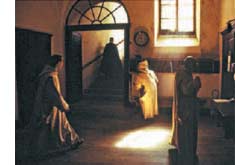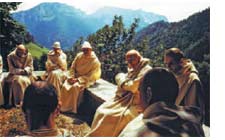There's a buzz in Germany about a movie in which there
are barely two minutes of dialogue, no interviews, no
voice-overs, no archival footage, and no sound track. In other
words, a silent movie. Or, more accurately, a movie about
silence.
For nearly three hours, Into Great Silence, directed
by Philip Groening, tracks the lives of resident monks in one of
the most ascetic monasteries in Roman Catholicism, the Grande
Chartreuse. The mother house of the strict Carthusian Order, it
was founded nearly one thousand years ago in the French Alps
between Grenoble and Chambéry, and little has changed
since then. The monks carry out their days in almost complete
isolation and silence, each inhabiting a two-story cell where he
works, prays, eats alone, and sleeps on a straw bed. The monks
leave their cells only three times every twenty-four hours to
journey down the corridor to the chapel.

This makes for a film of startling simplicity and unusual
concentration. The tolling of the bells announces each activity
during the tightly structured day: 8:00pm bedtime, 11:30pm rise
for prayer, 12:15am lauds and matins in the chapel for two to
three hours, 6:30am rise, 7:00am prayer, and so on throughout
the day. A single meal is delivered at midday. There is never a
full night of sleep. There is no free time. And there is no
fear, according to the filmmaker who shared the monks' rigorous
life over a period of six months to make his documentary of this
world set apart.
Into Great Silence has become a cult phenomenon in
Groening's native Germany, filling theaters and climbing the box
office charts since its premiere in November 2005 to reach the
rank of fifteen in movie attendance. That's a remarkable
achievement for a film in which virtually nothing happens. It
was awarded the World Cinema Special Jury Prize in the
documentary category at the prestigious Sundance Film Festival,
and distributors are quickly acquiring the rights to show it in
other European countries and in North America.
What's attracting these audiences? Unlikely that it's
nostalgia for the early days of silent film. Nor does the memory
of Andy Warhol's deathly boring eight hours of the Empire State
Building seen from a single point of view seem likely to ignite
enthusiasm in today's sophisticated cinema buffs. Could it be
something akin to a recent trend to convert monasteries into
chic hotels that has been sweeping through Italy, or the
popularity of staying at convents instead of equally pricey
hotels? That too is doubtful, since the preference for
cloistered accommodations probably reveals more about the skill
and ingenuity of marketers than it does about any real desire on
travelers' part to experience a medieval way of life.

Groening explains that he originally wanted to make a movie
about the present moment, about that single moment of time that
is always “now.” Only later did he realize that he
could do this by documenting life in a monastery, a place where
one's relationship to time is completely altered. As he put it,
“What is time for someone who knows that he will never
leave this building, this cell?” After waiting sixteen
years to be granted permission to enter the remote world of the
Grande Chartreuse, he moved into one of the cells, participated
in all aspects of monastic life, and shot his film in the two to
three hours allotted each day for labor. He worked entirely on
his own, with no artificial lights, no crew, nothing
superfluous.
Reviewers are praising the film's poetic vision, magnificent
austerity, visual splendor, and what one critic referred to as
nearly “tactile” sound. When all one hears is the
occasional rustling of cloth or opening of a door, the quality
of sound is essential to revealing the pervasive silence in
which the monks conduct their lives. Some have commented that
the film becomes a literal extension of the monastery and that
the theater itself embodies monastic space. It's this sense of
hermetic time, of the eternal, that Into Great Silence
seems to be offering moviegoers—a view into a world where
the present moment is all there is.
The recognition that solitude may have a beneficial, even
vital function in our busy contemporary lives is beginning to
surface in other places as well. A recent internet buzz was
created when a University of California neurobiologist named Leo
Chalupa proposed a national day of absolute solitude. Chalupa
believes an entire day spent without verbal exchange of any kind
with another person would be the best antidote for our
overtaxed, overstuffed brains and the ideal way to attain
optimal brain performance.
A researcher at the University of British Columbia has come
to similar conclusions. Psychologist Peter Suedfeld found that
“people are chronically stimulated, both socially and
physically” and that we “are probably operating at a
stimulation level higher than that for which our species
evolved.” His remedy? More time alone. And what to do
during all this time alone? Two French scientists have a
suggestion: listen to the silence. In their recent experiments
with eleven people who did just that, who listened to the sound
of silence, they discovered that such attentive listening can
actually help the brain to focus.
The silence of the Carthusian monk clearly is of a different
order and gravity altogether. The Carthusian monk listens for
God, and silence is the condition in which this can occur; it's
not the goal. But as the growing numbers of people wanting to
see Into Great Silence attest to, there are rewards for
taking the time to pay attention, to see and hear things
precisely—whether it's a few hours of mental freedom at
the cinema, improved brain performance, or finding God.
There couldn't be a better reason to go to the movies.






